The iPhone 6 Review
by Joshua Ho, Brandon Chester, Chris Heinonen & Ryan Smith on September 30, 2014 8:01 AM EST- Posted in
- Smartphones
- Apple
- Mobile
- iPhone 6
Battery Life
Battery life is undoubtedly one of the most important aspects of any smartphone. However, battery life is an enormous subject, and while it may seem simple on the surface there’s a great deal of underlying complexity. In order to try and cover the full breadth of use cases, we start with our baseline test, which is now the web browsing battery life test. In order to try and control for extraneous variables and get a good relative comparison, we standardize all displays to 200 nits on a full white display.
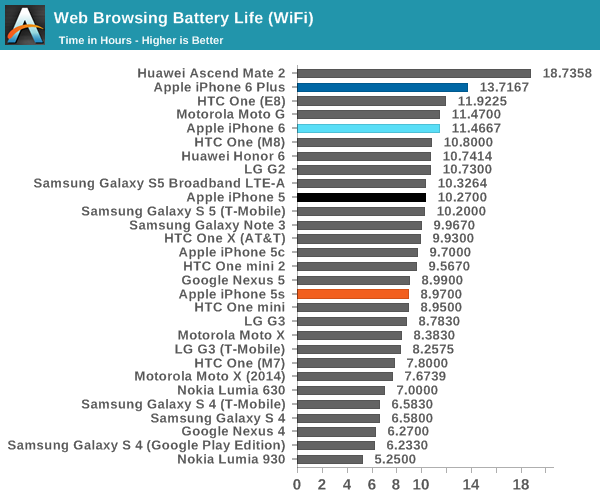
Our first test is in WiFi web browsing. As we can see, the iPhone 6 puts up a surprising showing for a phone with such a small battery. If anything, it seems that Apple leaned towards the conservative side in their advertised numbers as we managed to get higher than expected battery life. It may seem strange that the iPhone 6 achieves such a strong showing despite the small battery, but this is because the test is designed to avoid penalizing a phone for having a faster SoC or data connection.

In LTE web browsing, we see the same story. The iPhone 6 is about equal to or better than the competition, which is in line with what we would expect given the cellular architecture. In the case of the iPhone 6 and most other flagship smartphones this year, components such as Qualcomm’s QFE1100 envelope tracker, WTR1625 transceiver, and MDM9x25 modem have managed to make LTE power consumption approximately equal to WiFi power consumption. With the deployment of category 6 LTE and next generation RF components we could see LTE battery life exceed WiFi battery life.
While the web browsing test gives us a good picture of battery life in display-bound tasks, intensive use tends to be more SoC-bound. In order to see how phones compare in SoC-bound workloads, we turn to GFXBench, which has an infinite looping test. This test also provides a good idea of nominal performance. Unfortunately, for now we cannot report an accurate Basemark OS II battery life score as the test will stop when low battery notifications pop up on the screen. We are currently investigating methods to bypass this issue and report a final score in the near future.
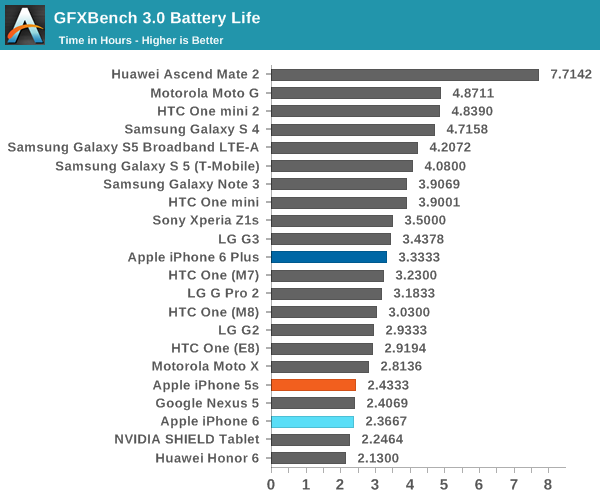
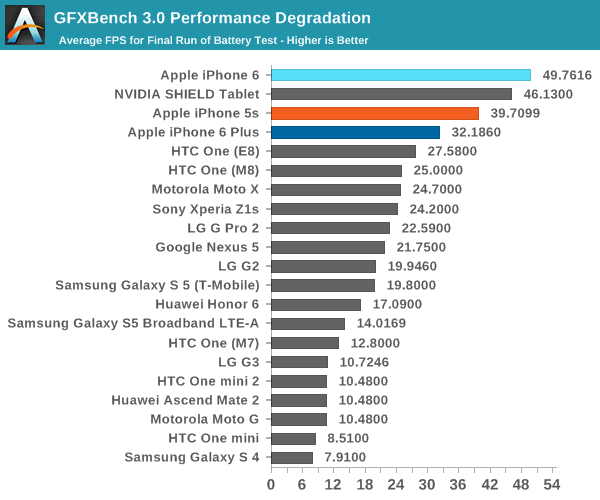
In the GFXBench test, at first it seems that the iPhone 6 is one of the worst for battery life under sustained load. However, once we look at the performance degradation over time it makes a lot more sense. This seems to be the type of workload that Apple referenced in their presentations, because this is the first phone I’ve seen that successfully does a full rundown without actually throttling. Of course, this does come with high skin temperatures. The phone definitely gets hot, but not uncomfortable. Using a FLIR camera, I saw peak temperatures of around 43 degrees Celcius, so it definitely doesn't exceed 50C in most conditions.
Normally, I would expect a 4.7” class smartphone to need a battery around the size of the HTC One (M7) or Motorola Moto X (2013) to keep pace with phones like the One (M8) and Galaxy S5, but Apple has pulled it off with a battery that is much smaller. There are two key factors that we can point to in this case. The first is the display, which can avoid pushing the LED backlight towards the higher current region that is much less efficient. This is because the amount of light-blocking circuitry is reduced and the active area of the display can be higher. The second aspect is the SoC, which is on a lower power 20nm process node. While TSMC’s 20nm process doesn’t have FinFET, improved silicon straining and high K metal gate make it possible to drive down active power and leakage when compared to 28nm processes. It’s also likely that the A8’s architecture is more efficient than other SoCs we’ve seen this year. However, it's important to note that without a capacitance and voltage table or something similarly concrete we can't really prove this statement.
Charge Time
While battery life determines the time spent away from a charger, the time spent attached to a charger is just as important. Even if most people charge their phones at night, there are plenty of cases where people don't have at least five hours to spend charging their phone. For example, forgetting to plug the phone into a charger before going to sleep or charging a phone between connecting flights are all times when charge time becomes crucial. In order to properly test for charge time, charge time is measured as the time from when the phone is connected to the charger to the time when the A/C adapter reaches its lowest power state with the phone still connected.
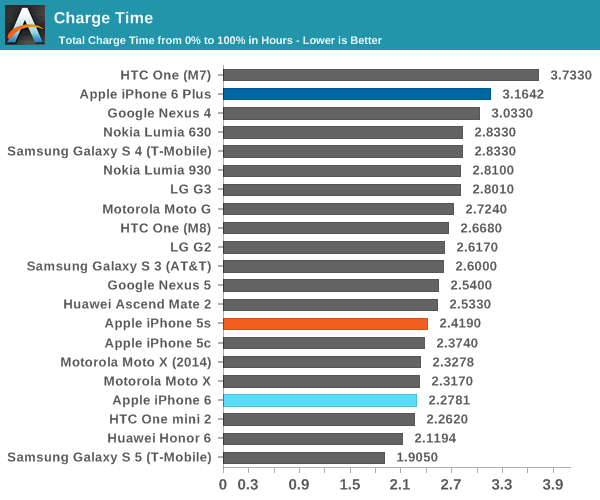
As you can see, the iPhone 6 performs reasonably well, and ends up in the same range as the iPhone 5s. The iPhone 6 Plus ends up on the high side because it ships with the same power adapter as the iPhone 6, which can provide a maximum of one amp at five volts.
Fortunately, based on the USB device information for the phones, both the iPhone 6 and 6 Plus support charging with power adapters like the iPad charging block that can provide up to 2.1 amps at five volts. Using one of these chargers will dramatically reduce charge time on the new iPhones, and it's a very worthwhile investment (assuming you don't already have an iPad) for the iPhone 6 Plus in particular.


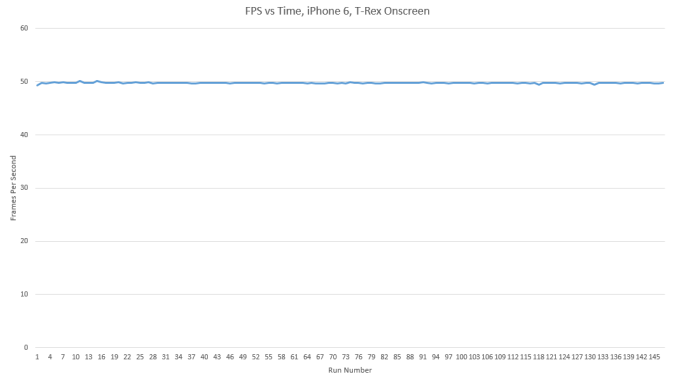
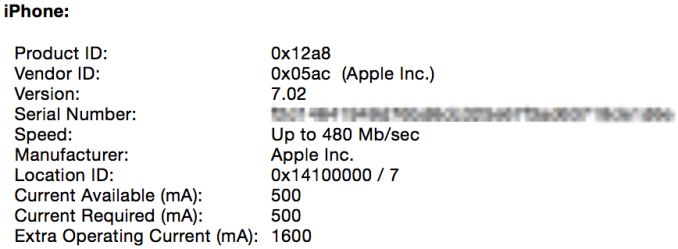








531 Comments
View All Comments
rUmX - Tuesday, September 30, 2014 - link
Wait for USB Type-C.mrochester - Wednesday, October 1, 2014 - link
Why are we waiting? We should have had it 2 years ago when Apple released the iPhone 5.grayson_carr - Tuesday, September 30, 2014 - link
Can't agree with you there. My wife has been through countless lightning cables. Apple branded cables either come apart at the seam between the connector and cable or just stop working after 6 months to a year with heavy use, even if there is no visible external damage. Just look at the reviews of Apple's lightning cable on their website and you'll see how terrible they are: http://store.apple.com/us/product/MD818ZM/A/lightn... (80% are 1 star out of 5). Apple covers one replacement, but after that you're on your own. Third party lightning cables, no matter how reputable the brand, always either stop working after a while or the iPhone will suddenly start saying the third party accessory is not compatible.I think the chip Apple requires in lightning cables is the culprit for most of these headaches. I think they die quickly, far before the lifetime of the cable itself, which is why cables will suddenly stop working for no apparent reason or start being labeled as not compatible.
Whatever the cause, I have NEVER had a micro USB die on me. Micro USB cables are also much cheaper than lightning cables. Finally, all of my other electronics use micro USB (Chromecast, Android phones, Kindles, cameras, etc.) which is awesome! I can have a single cable in my car that charges all of my gadgets (except my wife's stupid iPhone of course). For those three reasons, micro USB is far superior to lightning. Being able to insert the stupid cable either way doesn't come close to outweighing the benefits of micro USB I just listed.
mrochester - Tuesday, September 30, 2014 - link
And to respond to that, I've never had any Apple cables, whether it be the old dock connector or lighting cables and ports, break. Contrary to that, my sister's USB port in her Galaxy S3 broke, her Samsung charger ended up with bent pins and my partner's Samsung Galaxy S2 charger ended up fraying at the micro USB end.mrochester - Tuesday, September 30, 2014 - link
Of course, being able to insert the cable in any orientation and it being more reliable makes the benefits of the lighting connector far outweigh micro USB.grayson_carr - Tuesday, September 30, 2014 - link
Well, since reliability could go either way depending on your luck, we have...1) Being able to insert the cable in any orientation
vs.
1) Much lower price
2) A standard that is compatible with many more devices (Cameras, e-readers, Android phones and tablets, Windows phones and tablets, hard drives, portable speakers, etc., etc., etc.)
I would take the bottom two benefits any day over the top single benefit. Imagine if every company was as stubborn as Apple and designed their own cable. I would have to have 20 different types of cables lying around my house and it would be a HUGE pain trying to find the correct cable for the device. Instead, I can have one or two micro USB cables that can work with pretty much anything in my house, excluding iOS devices of course. That principle alone is enough to make me dislike Apple's lightning cable. Standards are a good thing. Proprietary sucks. Thank God other companies haven't followed Apple's footsteps in that regard yet. If they ever do, we're all screwed.
mrochester - Wednesday, October 1, 2014 - link
And I'd take the top one over the two things you listed. Having loads of micro-USB cables that are used by absolutely no devices in my house (my Canon camera is mini USB) isn't a whole lot of use. There's no need to have 20 different cables lying around your house, just 2. Your lightning cables for your iPad and iPhone, and a micro-USB cable for everything else that's stuck in 2012.GerryS - Wednesday, October 1, 2014 - link
I agree. The reversability is nice, but not much of a feature to me. Every other cable I use, except circular power connectors, requires a specific orientation. It never takes more than two tries to find the right one.techconc - Thursday, October 2, 2014 - link
@grayson_carr - Your argument falls apart in multiple places. For starters, you assume reversibility is the only advantage of the lightning cable. It's not. The lightning cable allows for 12W charging while USB is limited to just 9W. Further, you mention the ubiquity of the USB cable as if there is just one type of USB cable. I seem to have a variety of USB types of cables including micro, mini, Type A and Type B (not to mention other proprietary variants) around the house. Please explain to me how this "standard" is working any better for me or the public in general?grayson_carr - Tuesday, September 30, 2014 - link
By the way, if you're in the same boat as me, I have a tip... buy your lightning cables at RadioShack. You can buy insurance on them and it will then only cost $2 to get a replacement when they inevitably stop working.